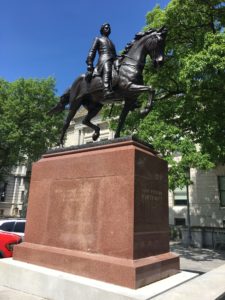3 Things Leaders Need to Understand About Engagement

John was a distant relative of a close friend of mine who once suffered through experiencing a severe lack of engagement with his team. John’s team members were all hand-picked volunteers, but when the time came for them to execute, every last one of them deserted him in his hour of need.
It was humiliating and demoralizing. However, John had clarity of purpose and, as there was a war on, he voluntarily threw himself into battle without his troops. He rallied several disorganized regiments and was awarded the Medal of Honor for his actions. After the battle, John assembled a new team of volunteers, served his country honorably for the duration of the war, and went on to have a distinguished career in public service.
Last week, I fired up the social media machine and polled my friends about the challenges they’re currently facing. “Engagement” was the top response.
 As I sat on a bench in Pennsylvania’s Capitol Park reviewing the poll results, past and present collided for me. I looked up and saw that directly across from me was the statue of my friend’s relative, Brevet Major General John F. Hartranft. It was then that I realized something with certainty about John; when his team deserted him, he learned a lot about engagement in a very short time.
As I sat on a bench in Pennsylvania’s Capitol Park reviewing the poll results, past and present collided for me. I looked up and saw that directly across from me was the statue of my friend’s relative, Brevet Major General John F. Hartranft. It was then that I realized something with certainty about John; when his team deserted him, he learned a lot about engagement in a very short time.
You likely won’t be deserted by your team on the eve of battle. But key employees will leave you at inopportune times. (Is there ever an opportune time?)
You’ll also learn the hard way that not all team members will share your organization’s values, and employees who appear “bought in” are really only there for a paycheck.
So, how do you overcome these issues to rope, saddle, and ride the mythical unicorn called “engagement”?
One of my friends who responded to the poll works with independent contractors who are expected to both sell and distribute product. She struggles with identifying qualified folks and getting them to engage fully. I think many leaders face her challenges because, with unemployment currently at 3.9 percent, everyone who works for you is an independent contractor.
That is the first key to understanding engagement—employees are not “yours.”
The current labor market, coupled with the changing expectations of employees, means that everyone is essentially a free agent who can go wherever they want whenever they want.
The second key to understanding engagement is alignment. For employees to be engaged you must:
- a) provide meaningful work
- b) within an inclusive, collaborative, supportive culture,
- c) driven by well-established and understood values,
- d) which creates purpose for all.
It is not enough for you to have A-players, the “right” folks in the right seats, exceptional products and services, and fantastic employee benefits. While those things are all important, they are not as critical as aligning work, culture, values, and purpose.
Finally, the third key to understanding engagement is YOU. People buy into people, which means that you are essentially a product.
Employees and customers must first want to buy into you before they get behind your goals.
Ask yourself:
- “What makes me different?”
- “Why do people want to engage with me?”
You are the ultimate value proposition, and that value will ripple outward and affect engagement. If you aren’t someone that your team wants to engage with, how can you ever expect them to engage with your organization’s work or each other?
Uncovering your personal value proposition allows you to distinguish yourself from every other competitor in the marketplace and engage at a higher level with both talent and customers.
John Hartranft learned about engagement the hard way, and I assume he figured out how to unlock his personal value proposition so that he could create alignment and work with free agents. He did so successfully, going on to raise a second regiment of volunteers that saw action in multiple campaigns for the remainder of the war.
In addition to other service, John went on to become the 17th Governor of Pennsylvania and was almost nominated as the Republican presidential candidate in 1876.
Not too bad for a man whose first public brush with engagement was so rocky.
Leadership is a journey, not a destination. Gain more insight in my ebook, Leadership in Real Life.
